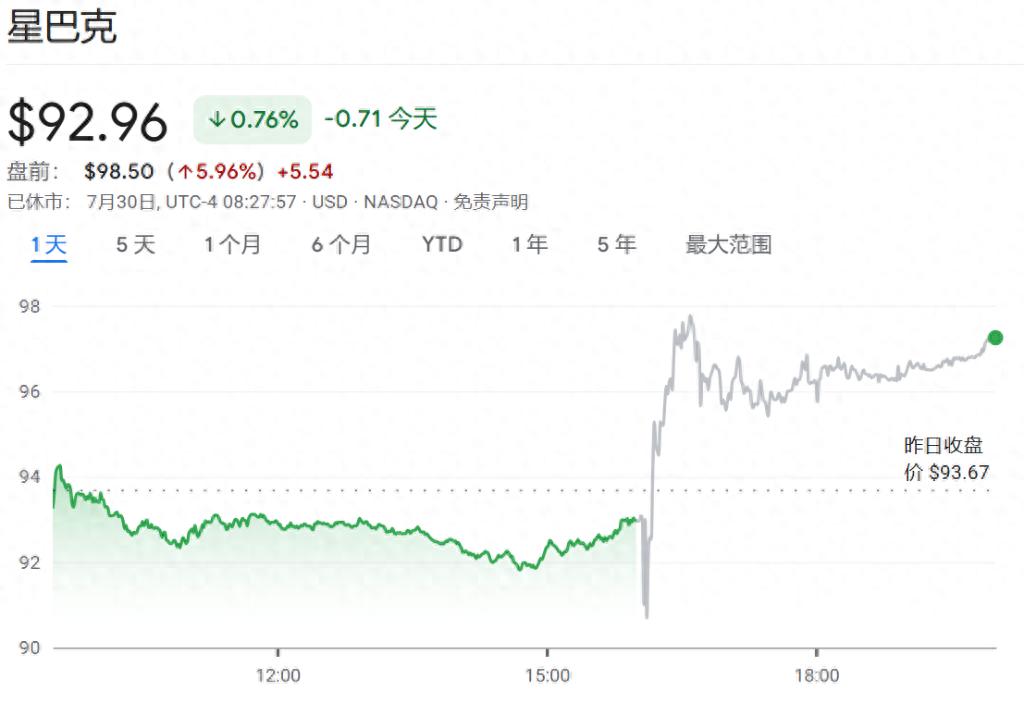Despite US same-store sales declining for six consecutive quarters, the overall decline was better than expected, as Starbucks’ reforms begin to show promise, with the market choosing to “believe first.”
The earnings report released on Wednesday showed Starbucks’ adjusted earnings per share were $0.50, below the market’s expectation of $0.65, but revenue performance exceeded expectations, reaching $9.5 billion, a year-on-year increase of 5%.
In key markets, same-store sales in the U.S. decreased by 2% in the second quarter, remaining flat compared to the previous quarter but better than analysts’ expectations of a 2.5% decline. Although comparable transaction volume fell by 4%, it still outperformed Wall Street’s anticipated 4.5% drop. Same-store sales in China continued to grow, as Starbucks attempts to emerge from its slump.
In response to this news, Starbucks’ stock price rose nearly 6% in premarket trading on Wednesday.

“We’ve solved many problems, done hard work on the tough things to build a solid operational foundation. Based on my transformation experience, we are ahead of schedule,” Brian Niccol, who successfully led Chipotle’s transformation, said in the announcement.
CFO Cathy Smith stated that while the company hasn’t provided specific guidance for the full year, “we have confidence that business will continue to improve in 2026.” She also emphasized that considering current consumer uncertainty, the company maintains a cautious outlook for the fourth quarter of this fiscal year.
US sales remain sluggish, but reforms are beginning to show
To reverse the trend, Starbucks has introduced a series of reform measures in the US market, including layoffs, requiring more employees to return to the office, and increasing staffing in stores while reshaping service models.
The new “Green Apron Service” plan will be fully implemented by mid-August, with pilot store data showing improvements in transaction volume, sales revenue, and service efficiency.
Additionally, Starbucks plans to invest approximately $150,000 per store in small-scale renovations to rebuild a “cozy café atmosphere,” replacing the previous store experience that leaned toward quick grab-and-go.
Construction costs for new stores have also decreased by about 30%, and a new prototype store with 32 seats and a drive-thru will be launched in the fiscal year 2026.
China Market Becomes a “Greenhouse” of Global Growth
Against the backdrop of a 2% year-on-year decline in same-store sales globally, the China market has emerged as a highlight, posting a 2% year-on-year increase, exceeding the expected 1.4%. Growth is primarily driven by increased transaction volume, although average transaction value has slightly declined, which is related to the company’s proactive price cuts to counter competition from Luckin Coffee.
This marks the second consecutive quarter that the China market has achieved positive same-store sales growth.
Starbucks management stated that they are seeking local partners to expand their long-term presence and “share the belief that this market holds significant growth opportunities.”
From “Promotion” to “Co-creation”
Faced with past criticism for an overly complex menu, Starbucks’ product innovation is also undergoing a transformation.
The new generation menu will launch in the fourth quarter with protein cold foam beverages, each containing 15 grams of protein and no added sugar, along with coconut water tea drinks and higher-quality handmade foods in development.
It’s worth noting that this round of innovation has shifted from a “top-down” approach led by headquarters to co-creation with store partners, which is closer to actual operations.
Nicole said, “We won’t just ‘dump’ new products from headquarters to the front line anymore; instead, we’ll involve store partners from the very beginning.”
This article is from Wall Street Journal, welcome to download the APP to view more.